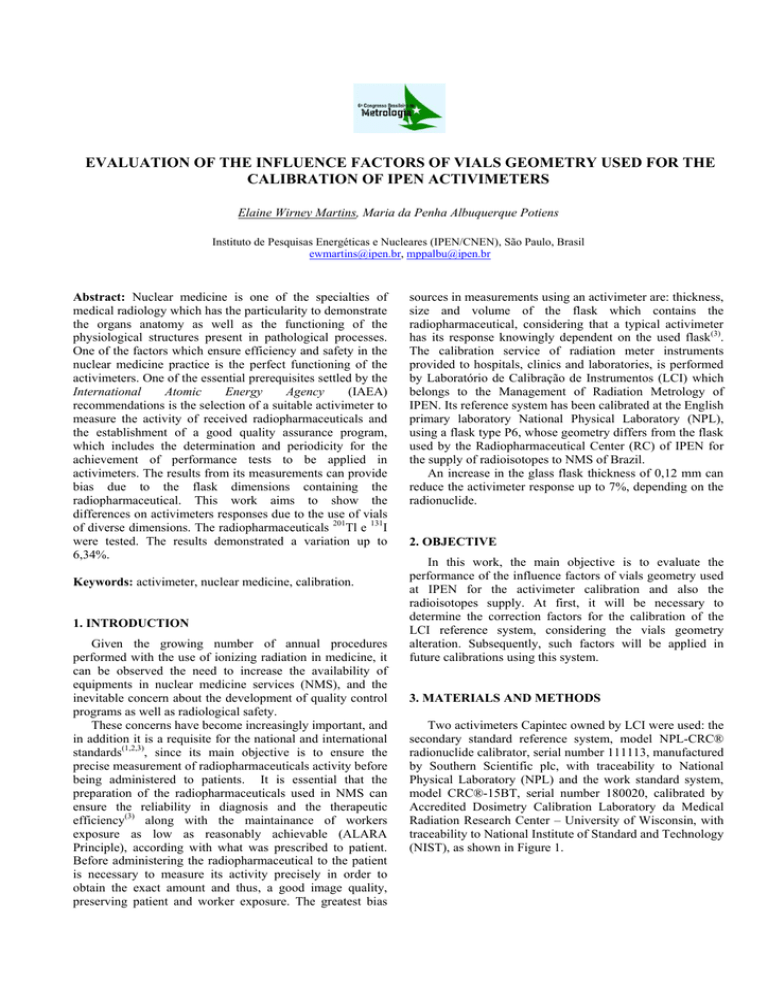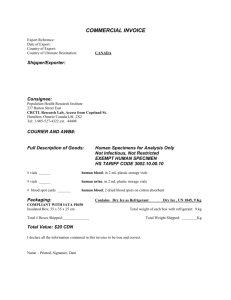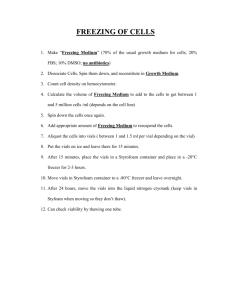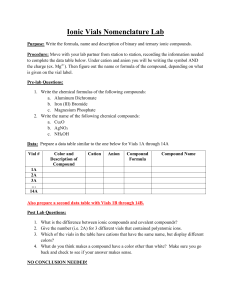EVALUATION OF THE INFLUENCE FACTORS OF VIALS GEOMETRY USED FOR THE CALIBRATION OF IPEN ACTIVIMETERS
advertisement

EVALUATION OF THE INFLUENCE FACTORS OF VIALS GEOMETRY USED FOR THE CALIBRATION OF IPEN ACTIVIMETERS Elaine Wirney Martins, Maria da Penha Albuquerque Potiens Instituto de Pesquisas Energéticas e Nucleares (IPEN/CNEN), São Paulo, Brasil ewmartins@ipen.br, mppalbu@ipen.br Abstract: Nuclear medicine is one of the specialties of medical radiology which has the particularity to demonstrate the organs anatomy as well as the functioning of the physiological structures present in pathological processes. One of the factors which ensure efficiency and safety in the nuclear medicine practice is the perfect functioning of the activimeters. One of the essential prerequisites settled by the International Atomic Energy Agency (IAEA) recommendations is the selection of a suitable activimeter to measure the activity of received radiopharmaceuticals and the establishment of a good quality assurance program, which includes the determination and periodicity for the achievement of performance tests to be applied in activimeters. The results from its measurements can provide bias due to the flask dimensions containing the radiopharmaceutical. This work aims to show the differences on activimeters responses due to the use of vials of diverse dimensions. The radiopharmaceuticals 201Tl e 131I were tested. The results demonstrated a variation up to 6,34%. Keywords: activimeter, nuclear medicine, calibration. 1. INTRODUCTION Given the growing number of annual procedures performed with the use of ionizing radiation in medicine, it can be observed the need to increase the availability of equipments in nuclear medicine services (NMS), and the inevitable concern about the development of quality control programs as well as radiological safety. These concerns have become increasingly important, and in addition it is a requisite for the national and international standards(1,2,3), since its main objective is to ensure the precise measurement of radiopharmaceuticals activity before being administered to patients. It is essential that the preparation of the radiopharmaceuticals used in NMS can ensure the reliability in diagnosis and the therapeutic efficiency(3) along with the maintainance of workers exposure as low as reasonably achievable (ALARA Principle), according with what was prescribed to patient. Before administering the radiopharmaceutical to the patient is necessary to measure its activity precisely in order to obtain the exact amount and thus, a good image quality, preserving patient and worker exposure. The greatest bias sources in measurements using an activimeter are: thickness, size and volume of the flask which contains the radiopharmaceutical, considering that a typical activimeter has its response knowingly dependent on the used flask(3). The calibration service of radiation meter instruments provided to hospitals, clinics and laboratories, is performed by Laboratório de Calibração de Instrumentos (LCI) which belongs to the Management of Radiation Metrology of IPEN. Its reference system has been calibrated at the English primary laboratory National Physical Laboratory (NPL), using a flask type P6, whose geometry differs from the flask used by the Radiopharmaceutical Center (RC) of IPEN for the supply of radioisotopes to NMS of Brazil. An increase in the glass flask thickness of 0,12 mm can reduce the activimeter response up to 7%, depending on the radionuclide. 2. OBJECTIVE In this work, the main objective is to evaluate the performance of the influence factors of vials geometry used at IPEN for the activimeter calibration and also the radioisotopes supply. At first, it will be necessary to determine the correction factors for the calibration of the LCI reference system, considering the vials geometry alteration. Subsequently, such factors will be applied in future calibrations using this system. 3. MATERIALS AND METHODS Two activimeters Capintec owned by LCI were used: the secondary standard reference system, model NPL-CRC® radionuclide calibrator, serial number 111113, manufactured by Southern Scientific plc, with traceability to National Physical Laboratory (NPL) and the work standard system, model CRC®-15BT, serial number 180020, calibrated by Accredited Dosimetry Calibration Laboratory da Medical Radiation Research Center – University of Wisconsin, with traceability to National Institute of Standard and Technology (NIST), as shown in Figure 1. (a) ) (b) Fig. 1. a) Reference system: NPL-CRC®, b) Work system: CRC®-15 BT. Fig. 3: Set of standard sources Eckert & Ziegler. For the geometry test, five different vials were used, as shown in Figure 2. Its dimensions are listed in Table 1. Two samples were used: 201Tl with initial activity of 4mCi and 131 I with initial activity of 5mCi. Both samples were homogeneously diluted in saline solution until completing the volume of 4ml per flask. Each standard source was supplied in a 27 ml polyethylene flask with uniform distribution of the active element in 20 ml of epoxy resin, composed of a density of approximately 1,0 g/cm3. These sources were manufactured by the German company Eckert & Ziegler Isotope Products (E&Z), with traceability certificates to National Institute of Standards and Technology (NIST). In Table 2 its characteristics are related. Table 2. Main characteristics of sources E&Z. Primary 2 1 3 5 4 Radionuclides photon Activity Uncertainty T1/2 Reference energy (MBq) (%) (days) date (keV) 133 Fig. 2: Glass vials of different geometries. 57 Ba 81; 356 9,55 ± 3,0 3853,6 01/11/09 Co 122 206,8 ± 3,0 272,11 01/03/10 662 7,26 ± 3,0 11015 01/11/09 137 Table 1: Vials dimensions used for the geometry test Wall Maximun Vials Height Diameter thickness volume nº (mm) (mm) (mm) (ml) 1 44,2 ± 0,06 19,5 ± 0,06 1,9 ± 0,06 7,3 2 46,8 ± 0,05 23,5 ± 0,05 1,5 ± 0,05 13,5 3 57,8 ± 0,05 26,5 ± 0,05 1,5 ± 0,04 22,9 4 58,4 ± 0,06 27,7 ± 0,04 1,4 ± 0,09 25,0 5 66,9 ± 0,04 29,6 ± 0,05 1,5 ± 0,05 32,9 The dimensions of the selected vials for the study present a difference of up to 0,5mm in the wall thickness. The measures concerning the vials geometry were performed with Mitutoyo pachymeter and feature total accuracy according to JIS B7507 Norm and Certificate nº 30697 – ISO 9002, its uncertainty is ±0,05mm. For the quality control tests it was utilized a set of standard sources used as reference conceded by the Centro de Tecnologia das Radiações (CTR) of IPEN. Three sealed sources: 133Ba, 57Co e 137Cs, are presented in Figure 3. Cs So far, for the quality control program, the automatic adjustment, tension and background tests were daily applied according to the international recommendations and manufacturer’s manuals (4,5,6,7). Precision and accuracy tests were applied after stabilization of the device, 10 readings were performed with a 30 seconds time interval between them. The precision test was calculated using the percentage deviation (P) between individual activity measure (Ai) and the measurements mean ( A ) according to equation 1. P (%) = 100 x ( Ai A ) A (1) In which: A = Arithmetic mean of the activity measures Ai = Activity of the individual source The accuracy test (E) was calculated using the percentage deviation between the average of the activity measures ( A ) relative to the mean of the first ten measures in the standard system with correction for the decay ( A10 ), given by the equation 2 (8,9,10,11): E(%)= 100 x ( A A10 ) A10 (2) In which: A = Arithmetic mean of the activity measures A10 = Arithmetic mean of the first ten measures in the standard system with correction for the decay of the date in which the test was realized. 3. RESULTS The tests were equally performed for each type of flask observing the variation of the measured activity with the flask geometry. It was performed 10 consecutive measures and their mean was calculated. In Table 3 it can be verified a greater response variation between flask 1 and 3 in the reference system as well as in the work system. The wall thickness of flask No. 1 is (1,92 ± 0,06mm) and of flask No. 3 is (1,53±0,04mm), i.e., difference of approximately 0,4 mm. The measures were performed using 201Tl sample with 148 MBq as initial activity. Table 3. Variation in response of activimeters in different geometry vials for 201Tl Vials NPL-CRC® CRC® - 15BT 1 106,54 ± 0,04 105,08 ± 0,09 2 112,29 ± 0,02 106,85 ± 0,01 3 113,75 ± 0,12 108,78 ± 0,11 4 109,62 ± 0,02 106,70 ± 0,03 5 Relative Deviation between vials 1 and 3 (%) 110,48 ± 0,07 105,90 ± 0,02 6,34 3,40 The activimeters also revealed differences in its responses using a 131I sample, as shown in Table 4. In vials number 1 and 4, the wall thickness presents about 0,5mm of difference. A 131I sample with 185 MBq as initial activity was homogeneously distributed in 4 ml saline solution in each flask. Table 4. Variation in response of activimeters in different geometry vials for 131I Vials NPL-CRC® CRC® - 15BT 1 167,98 ± 0,03 201,60 ± 0,02 2 170,72 ± 0,01 206,00 ± 0,01 3 170,53 ± 0,09 205,30 ± 0,09 4 171,81 ± 0,12 207,60 ± 0,09 5 Relative Deviation between vials 1 and 4 (%) 171,00 ± 0,05 205,30 ± 0,01 2,23 2,89 The quality control program presented the following results: Automatic adjustment: the reference value to the NPLCRC® suggested by the manufacturer is 0,03 mV and to the CRC®-15BT is -0,50 mV. The behavior of both activimeters was stable and did not present any variation of those values, following the acceptance limit of ±5% suggested by the manufacturer’s manual. Background radiation: during the test period, 10 measurements were performed daily. The NPL-CRC® activimeter, despite presenting higher values compared to CRC®-15BT, showed no values exceeding the acceptable range by the manufacturer (> 1MBq and < 20MBq). Tension: Both activimeters presented consistency in its results and within the limits suggested by the manufacturer (< 1.512V and < 504.7V) for reference and work systems respectively. Precision: the maximum percentage deviation between the individual activity measure (Ai) with respect to the measured mean activities (Ā) was less than 0,32% for all the tests performed, not exceeding the recommended limit of ± 5%, thus showing satisfactory results with reliability of 95% (8) . The results can be seen in Tables 5, 6 and 7, for 133Ba, 137 Cs and 57Co sources, respectively. Table 5: Results obtained for the precision test with the standard source 133Ba. Bário -133 NPL-CRC® CRC®-15BT Ā = 8,03 + 0,02 Ā = 7,93 + 0,01 Ai Precision Ai Precision (MBq) (%) (MBq) (%) 8,05 + 0,02 8,05 + 0,02 8,03 + 0,01 8,00 + 0,02 8,01 + 0,02 8,04 + 0,01 8,05 + 0,02 8,00 + 0,02 8,01 + 0,02 8,03 + 0,01 0,32 0,32 0,07 -0,30 -0,17 0,20 -0,05 -0,30 -0,17 0,07 7,93 + 0,01 7,93 + 0,01 7,93 + 0,02 7,90 + 0,03 7,90 + 0,03 7,93 + 0,02 7,93 + 0,02 7,93 + 0,02 7,93 + 0,01 7,93 + 0,01 0,08 0,08 0,08 -0,30 -0,30 0,08 0,08 0,08 0,08 0,08 Table 6: Results obtained for the precision test with the standard source 137Cs. Césio - 137 NPL-CRC® CRC®-15BT Ā = 6,93 + 0,02 Ā = 7,40 + 0,02 Ai Precision Ai Precision (MBq) (%) (MBq) (%) 6,92 + 0,02 -0,19 7,41 + 0,04 0,16 6,95 + 0,03 0,25 7,37 + 0,01 -0,38 6,96 + 0,03 0,39 7,37 + 0,01 -0,38 6,95+ 0,01 0,25 7,41 + 0,03 0,16 6,95 + 0,03 0,25 7,41 + 0,02 0,16 6,92 + 0,02 -0,19 7,41 + 0,02 0,16 6,92 + 0,02 -0,19 7,41 + 0,02 0,16 6,92 + 0,02 -0,19 7,41 + 0,03 0,16 6,92 + 0,02 -0,19 7,37 + 0,02 -0,38 6,92 + 0,02 -0,19 7,41 + 0,04 0,16 In the case of automatic adjustment tests there were no variations in its readings throughout the range they were realized. As for the tension test, although there were some variations as observed with the CRC-15BT activimeter, their data collection does not allow these values to perform ten measurements. Table 7: Results obtained for the precision test with the standard source 57Co. Cobalto -57 NPL-CRC® CRC®-15BT Ā = 169,3 + 0,08 Ā = 170,0 + 0,19 Ai Precision Ai Precision (MBq) (%) (MBq) (%) 169,2 + 0,01 -0,1 170,0 + 0,02 0 169,2 + 0,01 -0,1 170,0 + 0,02 0 169,3 + 0,02 0 170,0 + 0,02 0 169,4 + 0,01 0,1 170,4 + 0,01 0,2 169,3 + 0,02 0 170,0 + 0,01 0 169,4 + 0,01 0,1 170,0 + 0,01 0 169,3 + 0,02 0 170,0 + 0,01 0 169,2 + 0,01 -0,1 169,6 + 0,02 -0,2 169,3 + 0,02 0 170,0 + 0,02 0 169,4 + 0,02 0,1 170,0 + 0,02 0 4. CONCLUSION Activimeters response regarding the geometry test showed that their results vary in measurements due to the height, width and wall thickness differences between them. So far, the greatest difference between measurements was 6,34%. These differences must be considered in the determination of correction factors to be applied to vials in calibration of activimeters with traceability to NPL, as well as in the supply of radiopharmaceuticals that use those vials. The automatic adjustment, background and tension daily tests for both activimeters presented satisfactory results and within the limits established by the manufacturer. For the precision and accuracy tests its results were in agreement with the Brazilian standard for nuclear medicine services, CNEN-NE 3.05 that recommends the variation limit of up to 10% and 5% respectively. requirements for the competence of testing and calibration laboratories. ISO/IEC 17025, Genève, 2005. [3] M. Baker. Calibration of the NPL secondary standard radionuclide calibrator for the new 10R Schott, Type 1+ vials. Applied Radiation and Isotopes , v. 63, p. 71–77, 2005. [4] National Physical Laboratory. Protocol for establishing and maintaining the calibration of medical radionuclide calibrators and their quality control. A National Measurement Good Practice Guide, n. 93, NPL. Middlesex, United Kingdom, 2006. [5] Laboratoire National Henri Becquerel. Guide d’utilisation et de controle qualité dês activimètres. Societé française de radiopharmacie, França, 2006. [6] National Physics Laboratory Capintec NPL–CRC®. Radionuclide calibrator user’s manual. Ramsey, New Jersey, 1997. [7]Capintec CRC®-15 BT. Radioisotope dose calibrator owner’s manual. Pittsburg, PA, 2001. [8] Comissão Nacional De Energia Nuclear. CNEN-NN3.05. Requisitos de radioproteção e segurança para serviços de medicina nuclear. Resolução CNEN-10/96. Diário Oficial da União, 19/4/1996. [9 ] A.M. Costa. Métodos de calibração e de intercomparação de calibradores de dose utilizados em serviços de medicina nuclear. São Paulo: 1999. Dissertação (Mestrado) – Universidade de São Paulo. IPEN/USP. [10] S.G.P. Cecatti. Desenvolvimento de sistemas Tandem de activímetros e estabelecimento de dosimetria beta em serviços de medicina nuclear. São Paulo: 2004. Tese (Doutorado) – Universidade de São Paulo. IPEN/USP. ACKNOWLEDGESMENTS The authors thank to Conselho Nacional de Desenvolvimento Científico e Tecnológico (CNPq), to Fundação de Amparo à Pesquisa do Estado de São Paulo (FAPESP), to Coordenação de Aperfeiçoamento de Pessoal de Nível Superior (CAPES) and to Ministério de Ciência e Tecnologia (MCT), Project: Instituto Nacional de Ciência e Tecnologia (INCT) em Metrologia das Radiações na Medicina), the partial fincancil support. REFERENCES [1] Internacional Atomic Energy Agency. Quality assurance for radioactivity measurement in Nuclear Medicine. Technical report Series. IAEA, TRS 454, Vienna, 2006. [2]International Organization International Electrotechnical for Standardization. Comission. General [11] M.C.F Fragoso. Implantação de um programa de intercomparação de medidas de atividade de radiofármacos utilizados em serviços de medicina nuclear no Nordeste. Recife: 2010. Tese (Mestrado) – Universidade Federal de Pernambuco.


